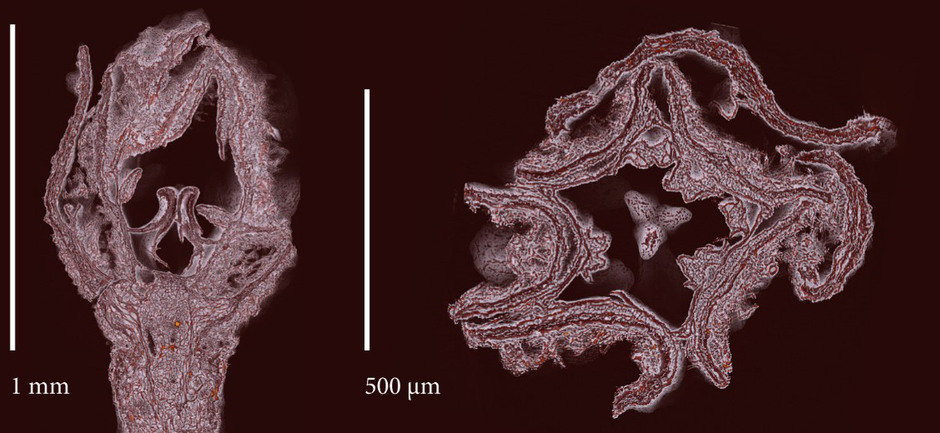Forskningsområden: Paleontologi
Forskningsämnen: Blomväxter och släkten, Fossil, Pollen, Växtevolution
Project overview
Project period: - running
Participating departments from the museum: Palaeobiology
Project description
The research is based mainly on small, exquisitely preserved Cretaceous age flowers, fruits, seeds and stamens of angiosperms and small reproductive units of other plant groups collected from Cretaceous deposits in Sweden, Denmark, Portugal and eastern North America.
The fossils are in the size range of 1-3 mm and termed mesofossils. They are charcoalified or lignitized, often with the original three-dimensional form and cellular details preserved. Morphological structures and organization of the fossils are studied using scanning electron microscopy and synchrotron X-ray microtomography (SRXTM). The SRXTM has been particularly helpful in extracting high resolution details of internal structures such as modes of placentation and embryos in seeds. The information is in digital form and provides a powerful tool for 3-D reconstructions and virtual sections, information that facilitates more detailed comparison with extant and extinct angiosperms.

Image caption: Caliciflora mauldinensis E.M.Friis, K.R.Pedersen & P.R.Crane from the earliest Cenomanian in Maryland, USA; virtual sections through flower bud based on X-ray tomographic data from synchrotron at Swiss Light Source, Paul Scherrer Institute, Villigen, Switzerland. Reconstruction: Else Marie Friis.
Funding
- Vetenskapsrådet (https://www.vr.se/)
Selected publications
- Friis, E.M., Crane, P.R., Pedersen, K.R. and Marone, F. (2024). Cretaceous chloranthoids: early prominence, extinct diversity and missing links. Annals of Botany 32:
- Friis, E.M., Crane, P.R. and Pedersen, K.R. (2024) The Cretaceous diversification of angiosperms: Perspectives from mesofossils. Geological Society of London, Special Publication Vol. 544- Cretaceous 200 https://doi.org/10.1144/SP544-2023-170
 External link..
External link.. - Friis, E.M., Crane, P.R. and Pedersen. K.R. (2023). Multipartite flowers with a distinct floral cup and multiovulate carpels: an Early Cretaceous angiosperm of probable lauralean relationship. International Journal of Plant Sciences 184: 87-105.https://doi.org/10.1086/723682
 External link.
External link. - Friis, E.M., Crane, P.R., and Pedersen, K.R. (2022). Early and mid-Cretaceous aristolochiaceous seeds from Portugal and Eastern North America. International Journal of Plant Sciences 183: 587-603. https://doi.org/10.1086/721259
 External link..
External link.. - Friis, E.M., Crane, P.R., Pedersen, K.R., Marone, F., (2022). Synchrotron radiation X-ray tomographic microscopy datasets for aristolochiaceous seeds from the Early Cretaceous of Portugal and North America. PSI Public Data Repository, https://doi.org/10.16907/bacdd377-981b-4934-8938-7eb9d8006224
 External link..
External link.. - Friis, E.M., Crane, P.R., Pedersen, K.R., Marone, F., (2022). Synchrotron radiation X-ray tomographic microscopy datasets for multipartite and cupulate flowers from Early Cretaceous mesofossil floras of Virginia, USA. PSI Public Data Repository, https://doi.org/10.16907/721beb60-0db2-4875-93bb-5329d52f68ac
 External link.
External link. - Friis, E.M., Crane, P.R., Pedersen, K.R., Mendes, M.M. and Kvaček, J. (2022). The Early Cretaceous mesofossil flora of Catefica, Portugal: angiosperms. Fossil Imprint 78 (2): 341–424. DOI 10.37520/fi.2022.016
- Friis, E.M., Crane, P.R. and Pedersen, K.R. (2011). Early Flowers and Angiosperm Evolution. Cambridge University Press, 585 pp.
Project members
External collaborators
The research is part of a long-term project carried out in close collaboration with other scientists. Main collaborators are K.R. Pedersen, Aarhus university, Denmark, and P.R. Crane, Yale University, Connecticut, and Oak Spring Garden Foundation, Virginia, U.S.A.

